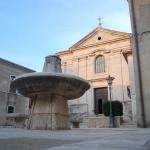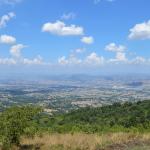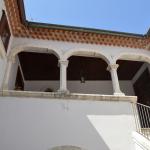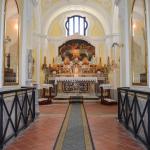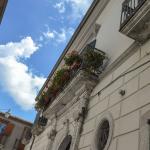The Municipality of Frigento is located within the area of the Ufita Valley. It's a town with 3,645 inhabitants, located 911 metres above sea level, at 40 km from Avellino. The territory covers 38.04 km² and overlooks the wide Ufita Valley to the north, the Fredane basin to the south, the Ansanto Valley to the east and the Calore basin to the west. The neighbouring municipalities are: Carife, Flumeri, Gesualdo, Grottaminarda, Guardia Lombardi, Rocca San Felice, Sturno and Villamaina.
The etymology of the name comes from Frequentum, Friquentum or Afrigentum: in the “Rationes Decimarum” of Campania (1308-1310) there is the Latin expression A populi frequentia, meaning “a crowd of people”. The inhabitants are called Frigentini and Saint Marciano is their patron saint.
PLACES OF INTEREST
- De Leo Palace - An aristocratic palace, today serving as “House of Culture”, it is a 19th-century building, home of the literary clergyman Marciano De Leo
- Archaeological Museum of Frigento - Built in the spaces of De Leo Palace, it traces the history of the village
- Church of Santa Maria Assunta in Cielo (Saint Mary of the Assumption into Heaven) - Former Cathedral, its current appearance is the result of the post-earthquake restoration of 1732
- Roman cisterns - Imposing water complex of the Roman period (I century BC), in opus incertum
- Church of San Marciano (Saint Marcian) - Church probably dating back to the 18th century, but whose origins could be even older, as attested by archaeological investigations carried out on the territory and the discovery of fragments of classical monumental inscriptions on the structure
- Aristocratic palaces - Buildings dating back to the 18th-19th century, with splendid portals in local stone; among all stands out Testa-Cipriano Palace, considered one of the most beautiful stately structures in the town
- Panoramica Limiti - Urban park with an extraordinary panoramic lookout with a view of all the surrounding valleys as far as the eye can see
- Ruins of Sant’Angelo al Pesco - Ruins of a medieval fortress, located 5 km from the centre, on a majestic rock spur
- Agricultural Complex “Il Parco” - Architectural complex characterised by the dovecote tower, located in a hilly agricultural area
- Sanctuary of the Madonna del Buon Consiglio (Our Lady of Good Counsel) – Centre of heartfelt Marian devotion, it is the mother house of the Institute of the Franciscan Friars of the Immaculate Mother
- Pinacoteca (Art Museum) - Within its walls is a permanent exhibition “Civic Art Collection of Pina Famiglietti", a collection of signature prints
- Hanging Gardens - Particularly decorative, they are located in the complex of private historic buildings
EVENTS
- La Tirata dei Carri Covoni (Dragging of the Sheaf Carts) - Ancient parade of the Sheaf Carts, made of stems and ears of wheat that takes place on 15 August, in honour of the Feast of the Assumption
- The Mysteries of Frigento - Exhibition in the Cathedral Church, during Lent, of papier-mâché representations of Christ’s Passion and death
- Cicerchiamo - Summer food and wine event, promoted by the Terra Mater Cooperative and Slow Food to celebrate the chickling vetch, a legume typical of the local biodiversity
- Svicolando - Summer festival of art, music, food and wine that offers the public many “visions” of the immense historical heritage of Frigento
- Feast and Fair of Our Lady of Good Counsel - Feast that takes place in the Sanctuary of the same name and in the square in front every 9 May
- Feast of the Accordion - Fixed summer appointment for all lovers of this ancient and popular musical instrument; takes place every year on 11, 12 and 13 August and includes the exhibition of many accordions also proposing excellent Irpinian food and wine
- Feast of Saint Roch - Solemn procession with the “mezzetti”, wooden containers used as a measure for wheat and artistically decorated with woven straw
- Pizzilli and Tammorre - Summer food and wine event organised by the Pro-Loco of Frigento, held on 6 and 7 August, to taste the fried pizzillo, stuffed with typical local products
TYPICAL FOOD AND PRODUCTS
- Irpinia Colline dell’Ufita PDO - Extra virgin olive oil deriving largely from the Ravece variety, characterised by a pleasant bitter and spicy taste
- Caciocavallo Silano PDO - Semi-hard cheese, with spun curd, produced with milk from different breeds of cows, including Podolica
- Lamb of Carmasciano PAT - Fresh meat of lambs of the Laticauda and Bagnolese breeds, carefully bred with herbs and hay enriched by the sulphurous exhalations of the Mefite
- Ufita garlic PAT - Product with an aromatic flavour and characterised by a high amount of essential oils and active agents
- Ricotta of Carmasciano PAT - White, with a soft and creamy consistency, obtained from the residual whey of the homonymous pecorino cheese, very sought out
- Pecorino of Carmasciano PAT - Sheep’s cheese produced in the homonymous locality found between Guardia Lombardi and Rocca San Felice: with an absolutely unique taste, it is characterised by a careful entirely artisanal preparation
- Menesta maritata - The name derives from the fact that the ingredients of meat and vegetables are put together, “married”
- Pizza jonna - Pizza made with corn flour
- Lo pelieo - An aromatic and wild herb of remarkable properties
- Cavatielli co’ lo pelieo - Pasta with the aromatic self-sown herb, a typical first course of the Irpinia tradition
- Caciocavallo irpino di grotta PAT - Spun curd cheese, produced with milk from small and medium-sized farms, from mainly Bruna cattle, traditionally aged in caves
FUN FACTS
The town is called the Balcony of Irpinia for its extraordinary panorama from which you can see 5 regions and 11 provinces.
HISTORICAL NOTES
In the territory of Frigento the remains of a sewage system, stone markers, terracotta and Latin inscriptions have been unearthed, testifying to the passage of the Republican and Imperial age. Perfectly preserved, moreover, is a complex of “cisterns” dating back to the first century BC but, instead of indicating the settlement of a population in a village, perhaps testify to a series of rustic villas built in that hilly area by the colonisers of nearby Aeclanum, probably chosen for the healthiness of the air.
Frigento belonged to the confederation of the Romans, in 851 it was owned by the Lombards and was included in the territories constituting the Duchy of Benevento. Its excellent position, at 911 metres above sea level, overlooking the entire Valle d’Ansanto, made it an important military centre and over time, allowed Ludwig II to divide the Duchy of Benevento into two principalities: that of Salerno, to which the Gastaldato di Conza was connected, and that of Benevento.
Frigento was one of the first cities to profess the Christian faith and the first bishop, San Marciano (patron saint of the city), dating back to the 5th century, was appointed by Pope Leo I the Great, in the period from 440 to 461.
Towards the middle of the 15th century, after the Norman rule and the war between the Aragonese and the Angevins, Frigento began to lose much of its ancient splendour, thus beginning a state of general abandonment, aggravated by numerous earthquakes and serious pestilences.
The scents, flavours and colours will not leave one indifferent. Frigento is always ready to welcome you with a multiplicity of activities to be explored and chosen on the basis of your interests
Frigento
Piazza Municipio, 1, 83040 Frigento AV, Italia
Did you like it? Leave a review
Your opinion is important! It will be visible after approval by the editorial staff.
To post a comment you must be an authenticated user. Log in with Social Login
